A full-scale figure of a terminator robot “T-800”, used at the movie “Terminator 2”, is displyed at … [+]
There’s been growing activity in antitrust. The would-be acquisition of Albertsons, the second-largest U.S. grocery operator, by number one Kroger was knocked asunder by a court. That may become a more unusual action with the replacement of Chair Lina Khan, whose term is over.
Donald Trump’s choice of the next FTC chair, current Commissioner Andrew Ferguson, has been talking about investigating online social media platforms “for unfair acts or practices relating to their opaque, unpredictable processes for banning users and censoring content.”
But no matter what exactly the new administration decides to do, it’s unlikely to address a growing problem any more than the Biden White House did — monopsony on a scale never before possible, thanks to artificial intelligence.
Monopsony is the concentration of purchasing power in the same sense that monopoly is the concentration of selling power.
The monopolistic concept is more familiar to people, maybe in part from the long-popular game as well as experience as consumers. A big box store comes into an area and pushes prices down, making competition difficult and sometimes driving smaller stores out of business. A large national company controls selling over a much larger and broader scale. Consolidation among corporations, with big fish getting even larger from swallowing up smaller ones, leads to a handful of companies controlling national markets.
Monopsony can be just as injurious. If there are few buyers, vendors have to compete with each other for business, typically on a price basis because that is what the monopsonist wants, lower costs.
And if the question is employment, monopsonists push down wages to again gain a price advantage. Even as massive corporations that hire hundreds of thousands of people, especially in areas with thin amounts of employment, can affect wages in places, they don’t tend to have the ability to throttle employment.
That is exactly what makes a handful of giant artificial intelligence vendors a new version of monopsonists. They create technology that can replace many people across multiple job types and industries. As Matt Beane, now an assistant professor in the Technology Management Program at the University of California, Santa Barbara but in 2015 a graduate student at MIT, told me then, “I don’t think we have a good handle on [automation replacing even white-collar workers]. The endgame scenarios seem kind of severe. From here on in, it’s really, really, really going to change and it’s going to change faster than we can handle.”
He was right. AI research started in the 1950s and many types have become commonplace and useful. The advent of generative AI — like the large language models that can often provide almost human-like conversation or text, or the programs that can create images and videos to order within seconds — has changed the nature of what is possible and what will happen.
Call center agents, writers, photographers, videographers, human language translators, artists, designers, lawyers, secretaries, and many more are subject to replacement. Probably not all in a given profession, but enough to leave people reeling. Pew Research last year took its guess and estimated that 19% of Americans were in jobs most exposed to AI and 23% of workers are in jobs that are the least exposed. Those numbers will expand.
Forget the argument made so often by those enamored with technology that the destruction of old jobs will open up new ones. Yes — some. Nowhere near the number lost. If that were not the case, why would companies invest all the money to automate if the same number of people would be employed except in higher-paying jobs? And there won’t be any sources of money to make up the losses because there never is a glorious future where all share in the lives of leisure that are possible.
Many top names in AI seem to gaze into the future, looking at the possibility of machines taking over the world with hyper-effective technology and trying to argue only they know how to avoid a real-life version of The Terminator.
All that, left unchecked by national policy, is a distraction. The danger is not in the future but now and the likely culprits aren’t sentient machines but businesspeople who want to make more money than ever before.

